Stories from the Field
Communities all across the country are working on and passing innovative policies and programs that counter commercial tobacco marketing and sales in the retail setting. They provide great examples of how to develop, pass, and implement effective policies, run successful media and awareness campaigns, and fight the “War in the Store.” Below, we provide a “Story from the Field” for each of our recommended Policy Solutions. Click on each to scroll down to the relevant section:
- Licensing, Zoning, and Retailer Density
- Tobacco Free Pharmacies
- Restricting Tobacco Advertising
- Restricting Product Availability
- Restricting Product Placement
- Restricting Product Packaging
- Increasing Tobacco Prices Through Non-Tax Approaches
- POS Health Warnings
- Tobacco 21
- Store Assessments
- Building Community Awareness
- Youth Engagement
- Engaging Stakeholders
- Reversing Point-of-Sale Preemption
Licensing, Zoning, and Retailer Density
Alachua County, Florida
In January 2019, Alachua County became the first place in Florida to implement a local tobacco retailer licensing policy, raise the minimum legal sales age for tobacco to 21, and require any new tobacco retailers to be located at least 1000ft away from schools. The county is also the first in the Southeastern US to implement tobacco retailer licensing at the local level. The State of Florida requires tobacco retailers to obtain a license for $50 annually; however, as the state definition of tobacco product does not include e-cigarettes, that licensing requirement does not extend to vape shops or other retailers that only sell e-cigarettes. Under Alachua County’s new ordinance, all retailers selling any type of tobacco product, including e-cigarettes, must apply for a county license yearly and pay a yearly licensing fee of $230. These policies were the result of many years of hard work shared by multiple partners. Learn more here about why they chose to focus on these policies, their key partners, and how they made the case for change.
Edgewater, Colorado
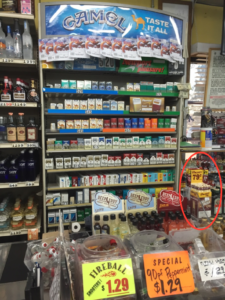 In November 2016, the city of Edgewater, Colorado voted unanimously to pass a tobacco retailer licensing law. It is the 7th community to pass a licensing ordinance in the state but first the first to include licensing for cigarette sales. The licensing ordinance prohibits self-service displays for all tobacco products and tobacco product paraphernalia, including electronic smoking devices (ESDs), prohibits individuals under 18 from entering a tobacco retail business without a parent or guardian, establishes a penalty system for violations, and more talked with Tracy Doyle, Policy Specialist with the Tobacco Prevention Initiative at Jefferson County Public Health, who worked on the ordinance, to learn why Edgewater was the first in the state to include licensing for cigarette sales, what the goal of the ordinance was, who was involved in its passage, how they made the case for the policy, and what’s next. Read more.
In November 2016, the city of Edgewater, Colorado voted unanimously to pass a tobacco retailer licensing law. It is the 7th community to pass a licensing ordinance in the state but first the first to include licensing for cigarette sales. The licensing ordinance prohibits self-service displays for all tobacco products and tobacco product paraphernalia, including electronic smoking devices (ESDs), prohibits individuals under 18 from entering a tobacco retail business without a parent or guardian, establishes a penalty system for violations, and more talked with Tracy Doyle, Policy Specialist with the Tobacco Prevention Initiative at Jefferson County Public Health, who worked on the ordinance, to learn why Edgewater was the first in the state to include licensing for cigarette sales, what the goal of the ordinance was, who was involved in its passage, how they made the case for the policy, and what’s next. Read more.
Licensing for E-Cigarette Retailers and Vape Shops
In April 2016, the Washington state legislature adopted rules to create a statewide licensing system for businesses that sell and distribute “vapor products,” including liquid nicotine. The state estimates that approximately 6,000 retailers will be affected by the new licensing rules, along with roughly 150 “vapor products” distributors. The rules, which are expected to take effect in fall 2016, require retailers to obtain a separate license to sell “vapor products” online. In addition, many local communities have adopted their own licensing and permit requirements for e-cigarette retailers and vape shops. For example, San Marcos, California, recently passed an ordinance requiring any shop that sells tobacco products, including e-cigarettes and related devices, to purchase a city-issued “tobacco retail license.” The city partnered with the San Marcos Prevention Coalition and the Vista Community Clinic, which conducted surveys of local e-cigarette retailers and vape shops and determined that a number of businesses were selling these products to minors in violation of state law. San Marcos plans to use the tobacco license fees (roughly $190 per establishment) to ensure that businesses are complying with tobacco control regulations, including restrictions on selling to underage users. (California recently raised the minimum legal age to purchase tobacco and e-cigarette products from 18 to 21.) Ensuring regulatory compliance at the point of sale is just one of many ways in which licensing e-cigarette retailers and vape shops can be an effective tobacco control tool for both state and local governments. Read more.
San Francisco, California
A retailer licensing policy can help a community monitor and manage the number of tobacco retailers and is a typical policy lever pulled by towns or cities to manage the number of alcohol retailers. San Francisco’s Tobacco Use Reduction Act aims to halve the number of tobacco retailers in the city over the next 10-15 years by creating a cap of 45 tobacco sales permits in each of the 11 city districts. This cap aims to reduce disparities in retailer density in lower income and minority communities. For more details on the city’s strategy and lessons learned, review Reducing Tobacco Retail Density in San Francisco: A Case Study. Watch this video from the youth of San Francisco’s Tobacco Use Reduction Force (TURF) to learn more about the law and why it is so important.
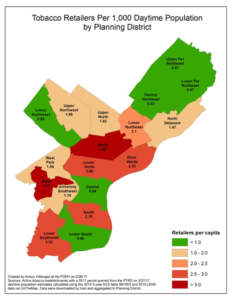 Philadelphia, Pennsylvania
Philadelphia, Pennsylvania
In December of 2016, the Philadelphia Board of Health passed new tobacco retailer regulations that will ultimately lead to a reduction in the total number of tobacco retailers in the city, a reduction in the number of retailers near schools, as well as a reduction in disparities in retailer density seen across different neighborhoods. The new regulations set a cap on the total number of tobacco retailer permits, limiting them to 1 per 1,000 people in each planning district. In addition, the regulations restrict any new retailer from locating within 500 feet (or approximately two blocks) of K-12 schools. Learn more here about why the city chose these policies in particular, how they raised awareness of the problem, gained support for and passed the policies, and what they’re planning next.
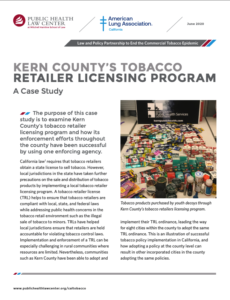 Kern County, California
Kern County, California
This case study from the Public Health Law Center and the California American Lung Association highlights the tobacco retailer licensing program in Kern County, CA, which has found success by using one lead enforcement agency to cover all of the county’s unincorporated areas and participating cities that have also adopted the county’s ordinance.
Golden Valley, Minnesota
In October 2019, the suburban city of Golden Valley in Hennepin County, Minnesota passed a number of comprehensive tobacco prevention policies. These policies covered a broad range of prevention strategies, including raising the minimum legal sales age to 21, banning the sale of all flavored tobacco products, increasing tobacco product prices, capping the number of tobacco retailer licenses issued, increasing violation penalty fees for tobacco retailers, and more. In June 2020, they passed additional regulations under the city’s zoning code to restrict the location of tobacco retailers and their proximity to youth-oriented facilities. Learn more here.
Multnomah County, Oregon
In 2015, Multnomah County, Oregon adopted a tobacco retailer licensing ordinance. According to this case study, “…local health officials discovered the county’s rates of illegal cigarette sales to minors were higher than the state average – a sobering fact, considering that Oregon had the nation’s highest rate of illegal sales in 2013. Given that nearly 9 out of 10 people who smoke start by age 18,4 reducing the percentage of youths who start using tobacco products could significantly improve the health outcomes associated with long-term tobacco use. But the officials found that there was no method for tracking tobacco retailers in order to enforce minimum purchase age laws…. the [tobacco retailer licensing] law was a result of comprehensive outreach and coordinated, persistent work by local organizations, youth groups, government departments, and legislators. It is a strong example of a community-driven response to combat the harmful effects of tobacco product use on youths and on public health more generally.” Learn more in the full case study from the Multnomah County Health Department and ChangeLab Solutions – No More in Multnomah! Youth Call for an End to Illegal Tobacco Sales and in the Health Equity Impact Assessment conducted prior to passing the policy.
Hayward, CA
According to this case study from the California Tobacco Endgame Center for Organizing and Engagement,” in July 2020, the Hayward City Council amended its Tobacco Retail License (TRL) policy to remove both the exemption of menthol flavored tobacco products and exemptions applying to existing licensees, thus eliminating the sale of flavored tobacco products citywide. Additionally, the Council enacted several provisions to strengthen the TRL. The effort was led by Eden Youth and Family Center (EYFC), the Asian Pacific Islander Coalition for Health Against Tobacco (API-CHAT) and the Alameda County Tobacco Control Program (TCP) – a broad community of organizations that marshalled a powerful and diverse base of support, leveraging youth and community voices and social equity issues.” Read the full case study: Leveraging the community voice and equity issues to strengthen tobacco retailer licensing policy in Hayward.
Colton, CA
According to this case study from the California Tobacco Endgame Center for Organizing and Engagement, “Colton Community Coalition for Change (Coalition), a community outreach program of Mental Health Systems Central Valley Prevention Program (MHS), and its community partners spent nearly two-and-a-half years cultivating support for a comprehensive Tobacco Retail License (TRL) policy for the City of Colton. The lengthy campaign overcame several roadblocks before a TRL policy was adopted in December 2019, including delays and leadership changes both among the coalition members and political leadership in Colton, illustrating the powerful roles of community partnerships and youth voices.” Read the full case study: Community campaigns to reduce youth access to tobacco products in Colton, CA.
Santa Maria, CA
This case study from the Public Health Law Center describes how the City of Santa Maria addressed the youth vaping epidemic by adopting a comprehensive tobacco retail license ordinance, which restricts the sale of flavored commercial tobacco products, including e-cigarettes. Their licensing program also set a minimum price of $7 for a pack of cigarette, set a minimum price of $5 for a pack of cigarillos or cigars, and requires tobacco products to be sold at the full retail price with no coupons, discounts, or deals.
Tobacco Free Pharmacies
CVS Health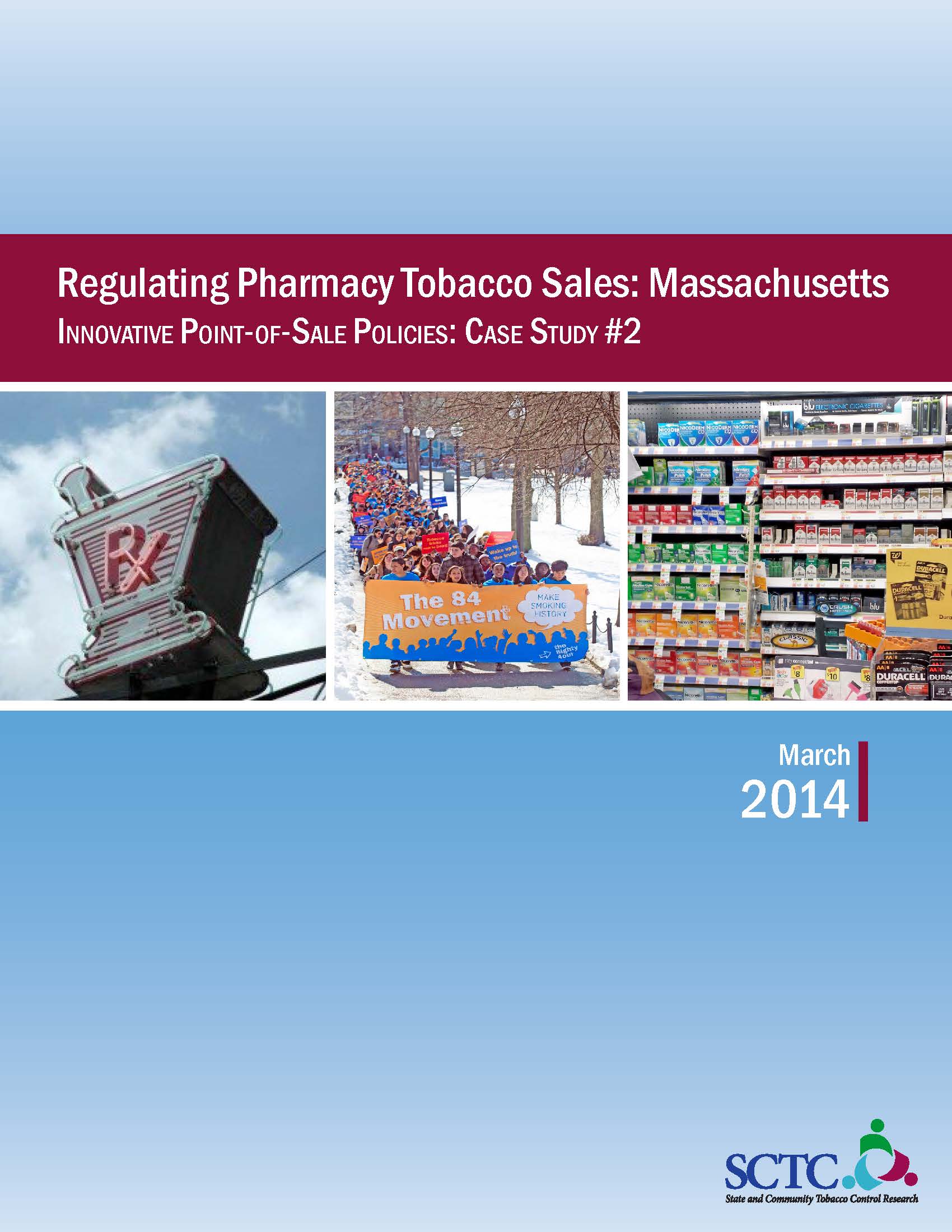
In 2008, San Francisco became the first city in the U.S. to ban tobacco sales in pharmacies. In February 2014, CVS announced its decision to stop selling tobacco products, becoming the first retail pharmacy chain in the U.S. to take such action
Massachusetts
In Massachusetts, over 80 cities and towns have enacted similar bans as of February 2014. Learn more about Massachusetts’ success in ‘Regulating Pharmacy Tobacco Sales: Massachusetts,‘ the second case study in the Innovative Point-of-Sale Policies series from the Center for Public Health Systems Science at Washington University in St. Louis. Also, check out our Tobacco Free Pharmacies Action Guide for recommendations and tools.
Restricting Tobacco Advertising
New York State
Tobacco Free New York State (TobaccoFreeNYS) is a non-profit organization dedicated to making New York State a healthier place to live, work, and play. Their media campaign, “Tobacco Marketing Works,” aims to “educate New Yorkers about the dangers of tobacco industry marketing in retail stores, and the effect that this marketing has on New York’s youth. Mass media campaigns have the potential to influence attitudes about POS advertising and increase support for policies that restrict tobacco promotion at the point of sale.[17] In addition to a campaign targeting the public, TobaccoFreeNYS and community partners are asking local retailers to “remove, reduce or rearrange” tobacco advertising in and around their stores. Visit TobaccoFreeNYS.org for links to audio, video and print ads, as well as a host of community resources to counter industry marketing at the point of sale. Also see TobaccoFreeNYS on YouTube:
Orangeburg, SC
After conducting retail store assessments at all 26 retailers in Bamberg County and receiving training on point-of-sale tobacco control from Counter Tools, the Tri-County Commission on Alcohol and Drug Abuse (TCCADA) was looking for next steps to help address the glut of tobacco marketing present in their community. As the name implies, the Commission covers two other counties in South Carolina: Orangeburg and Calhoun. TCCADA planned to conduct store assessments in those two counties as well, and they took a look at the tobacco control laws currently on the books in all three counties. What they found was a happy surprise: both the county and the city of Orangeburg already had a policy on the books within their zoning ordinance that limits the amount of advertising on the exterior of stores to 25% of the wall area. However, this signage ordinance had not been enforced. TCCADA’s agency director contacted the county administrator and zoning administrator, who sent out warning letters to stores, notifying them of the ordinance and notifying them that there would be upcoming inspections to ensure compliance with the code. Learn more and see the before & after photos here.
Restricting Product Availability
San Francisco, California: Prohibiting the Sale of All Flavored Products, Including Menthol Cigarettes
In June 2017, San Francisco became the first city to completely restrict the sale of any flavored tobacco product, including menthol, within the city limits, without exception. Learn about the groundwork involved in making it happen and the ongoing work to keep the policy on the books.
Minneapolis, Minnesota
Minneapolis Flavor Restrictions: Minneapolis, MN enacted restrictions on the sale of flavored tobacco products, other than menthol flavored, limiting them to adult-only tobacco stores. These restrictions apply to products such as cotton candy-flavored shisha, apple-flavored chewing tobacco, grape-flavored little cigars, and e-liquids that are sold in thousands of kid-friendly fruit and candy flavors. At the same time, the city of Minneapolis also set a minimum sales price for cigars of $2.60 each or $10.40 for packs of four or more. Read more.
San Francisco, California: Restricting The Number of Tobacco Retailers
A retailer licensing policy can help a community monitor and manage the number of tobacco retailers and is a typical policy lever pulled by towns or cities to manage the number of alcohol retailers. San Francisco’s Tobacco Use Reduction Act aims to halve the number of tobacco retailers in the city over the next 10-15 years by creating a cap of 45 tobacco sales permits in each of the 11 city districts. This cap aims to reduce disparities in retailer density in lower income and minority communities. For more details on the city’s strategy and lessons learned, review Reducing Tobacco Retail Density in San Francisco: A Case Study. Watch this video from the youth of San Francisco’s Tobacco Use Reduction Force (TURF) to learn more about the law and why it is so important.
Local Menthol Policy Case Studies: Minneapolis, St. Paul, and Duluth, MN + Oakland, CA
This webinar offers case studies for successfully passed local policies restricting the sale of menthol tobacco products. Come find out Minneapolis, St. Paul, and Oakland were able to pass their policies, who helped, lessons learned, and more.
- Download a case study on the menthol policies passed in Minneapolis, St. Paul, and Duluth, MN here, including background, their process for education and outreach, a timeline, how they overcame industry opposition and other challenges, and lessons learned.
- Download another case study about Oakland’s policy, which also prohibited pharmacies from selling tobacco, set a minimum price of $8 for a pack of cigarettes, and set a minimum pack size of 20 little little cigars/cigarillos: City of Oakland closes loophole in flavored tobacco products policy, strengthens enforcement.
 Philadelphia, Pennsylvania
Philadelphia, Pennsylvania
In December of 2016, the Philadelphia Board of Health passed new tobacco retailer regulations that will ultimately lead to a reduction in the total number of tobacco retailers in the city, a reduction in the number of retailers near schools, as well as a reduction in disparities in retailer density seen across different neighborhoods. The new regulations set a cap on the total number of tobacco retailer permits, limiting them to 1 per 1,000 people in each planning district. In addition, the regulations restrict any new retailer from locating within 500 feet (or approximately two blocks) of K-12 schools. Learn more here about why the city chose these policies in particular, how they raised awareness of the problem, gained support for and passed the policies, and what they’re planning next.
Massachusetts Local Flavor Policies
Additional resources:
- The association between neighborhood racial composition and menthol cigarette pricing in Boston,MA, Health & Place
- Short-term impact of a flavored tobacco restriction: Changes in youth tobacco use in a Massachusetts community, American Journal of Preventative Medicine
- Impact of flavoured tobacco restriction policies on flavoured product availability in Massachusetts, Tobacco Control
- Evaluating tobacco retailer experience and compliance with a flavoured tobacco product restriction in Boston, Massachusetts: Impact on product availability, advertisement and consumer demand, Tobacco Control
Chicago, Illinois
- Chicago POS Legislation includes a ban on selling flavored tobacco, including menthol, within 500 feet of a school.
Restricting Product Placement
Haverstraw, New York
In 2012, the Village of Haverstraw, NY enacted a ban on the display tobacco products, specifically at stores that are open to minors. This law would have marked the most progressive local policy on tobacco display bans to date in the United States. Unfortunately, the New York Association of Convenience Stores and 7 major tobacco companies filed a lawsuit contesting that this policy violated their First Amendment rights to freedom of speech. In response, Haverstraw withdrew its ban to avoid a court battle that would be costly for a small town to fight. Read more.
New York City
- Tobacco Product Display Restriction: would have banned the display of any tobacco products or tobacco product packaging and set an age restriction of 18 for entering retail tobacco stores, but this bill was dropped and never voted on.
Restricting Product Packaging
New York City
- Sensible Tobacco Enforcement: set a ban on price promotions, a floor price of cigarettes and little cigars, a minimum pack size for little cigars and cigarillos, and more.
Increasing Tobacco Prices Through Non-Tax Approaches
St. Paul, Minnesota
In November 2021, St. Paul, MN passed a set of retail tobacco policies that will help improve health equity, reduce youth tobacco use, and reduce the presence of tobacco across communities in the city. These included minimum floor prices for both cigarettes and smokeless tobacco products, a ban on price discounts and coupon redemption for all tobacco products, tobacco retailer density limits, and more. We had the privilege of talking with two representatives from the Association for Nonsmokers-Minnesota (ANSR-MN), an organization that helped lead the organizing and advocacy efforts that brought these policies to fruition, including community organizing efforts and a fantastic media campaign called “Don’t Discount My Life.” Learn more in Point-of-Sale Pricing Policies in St. Paul: A Story from the Field.
New York City

In 2013, New York City passed a comprehensive point of sale policy, Sensible Tobacco Enforcement, which restricted price discounts by prohibiting retailers from redeeming coupons or honoring other price discounts for tobacco products, set a minimum price for cigarettes and little cigars at $10.50 per pack, set minimum packaging requirements, and increased enforcement and penalties for tax evasion. At the same time, the city also passed legislation that raised the minimum age to purchase tobacco and e-cigarettes from 18 to 21. Learn more about NYC’s point of sale policy success, the policies’ impacts on public health, legal considerations, and lessons learned in Reducing Cheap Tobacco & Youth Access: New York City, a case study in the Innovative Point-of-Sale Policies series from the Center for Public Health Systems Science at Washington University in St. Louis.
Providence, Rhode Island
In 2012 Providence R.I. became the first municipality in the U.S. to prohibit tobacco retailers from selling tobacco products at a discount, through multi-pack or buy-some-get-some-free deals, and redeeming coupons that provide tobacco products for free or at a reduced price. They also banned the sale of flavored non-cigarette tobacco products (except for menthol, mint or wintergreen). These policy successes were the result of a multi-year campaign that included passing a successful licensing policy, conducting store assessments and public opinion surveys, the development and promotion of the Sweet Deceit media campaign, and building community and political support around the issue. After being challenged in court by the tobacco industry, the provisions were upheld by the First Circuit Court of Appeals and went into effect in 2013.
Learn more about Providence’s tobacco pricing policy success in Regulating Price Discounting in Providence, R.I., a case study in the Innovative Point-of-Sale Policies series from the Center for Public Health Systems Science at Washington University in St. Louis.
Golden Valley, Minnesota
In October 2019, the suburban city of Golden Valley in Hennepin County, Minnesota passed a number of comprehensive tobacco prevention policies. These policies covered a broad range of prevention strategies, including raising the minimum legal sales age to 21, banning the sale of all flavored tobacco products, increasing tobacco product prices, capping the number of tobacco retailer licenses issued, increasing violation penalty fees for tobacco retailers, and more. In June 2020, they passed additional regulations under the city’s zoning code to restrict the location of tobacco retailers and their proximity to youth-oriented facilities. Learn more here.
Sonoma County, California
According to this case study from ChangeLab Soultions: “In 2016, the Sonoma County Board of Supervisors approved a jurisdiction-wide tobacco retailer licensing ordinance that set a minimum price of $7 per pack for cigarettes, little cigars, and cigars sold in unincorporated areas of the county. The ordinance established a licensing program for all Sonoma County tobacco retailers and was the second tobacco retailer licensing initiative in the country to impose a tobacco price floor, after New York City.” Read the full case study – Floor Pricing: Sonoma County Leads on Tobacco Control
San Francisco, California
San Francisco adopted a Cigarette Litter Abatement Fee at the rate of 20 cents per pack of cigarettes. Since then, the fee has increased to 85 cents per pack. According to a 2009 report from the Health Economics Consulting Group, the city of San Francisco spent over 6 million dollars in 2008 removing cigarettes from gutters, drainpipes and sidewalks. San Francisco has also proposed a fast food litter fee. No studies have assessed the effectiveness of this approach on raising prices, but presumably the impact would be akin to an excise tax. For more information, see the text of the San Francisco Ordinance of Cigarette Litter Abatement Fee.
POS Health Warnings
New York City, New York
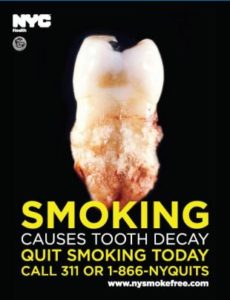 The New York City Board of Health passed a resolution in September 2009 requiring health warnings and cessation information to be placed near the cash register or near the tobacco product display everywhere tobacco is sold in New York City. Preliminary research with adult current smokers and recent quitters both before and after the signs were posted showed an 11% increase in respondents who were thinking about quitting smoking.
The New York City Board of Health passed a resolution in September 2009 requiring health warnings and cessation information to be placed near the cash register or near the tobacco product display everywhere tobacco is sold in New York City. Preliminary research with adult current smokers and recent quitters both before and after the signs were posted showed an 11% increase in respondents who were thinking about quitting smoking.
Unfortunately, in June 2010, the regulation was challenged in court by Phillip Morris, R.J. Reynolds, Lorillard, and a convenience store trade group in 23-34 94th St. Grocery Corp. v. N.Y. City Board of Health. In December 2010, the court ruled that implementation of the warnings was preempted by the Federal Cigarette Labeling and Advertising Act (FCLAA). This ruling was upheld in the U.S. Court of Appeal for the Second Circuit in July 2012. Review the following resources for more information about New York City’s resolution, the legal battle, and what it means for other cities looking to implement similar policies:
-
-
- Public Health Law Center’s “New York City Graphic Warning Sign Requirement & Litigation” fact sheet
- Brief of Amicus Curiae filed in support of the New York City Board of Health on behalf of several city public health departments
- ChangeLab Solutions’ FAQs on the New York City rulings
-
Jefferson County, Alabama
Jefferson County, Alabama pioneered an innovative program based on voluntary commitments of storeowners to the health of their communities. The United Way of Central Alabama and the Jefferson County Department of Health have worked together to start a program in which retailers post health warning signs in their stores. Signs were created based partially on the new graphic warning labels required by the 2009 FDA Act. Encouragingly, 51 convenience store owners voluntarily agreed to post the warning signs in their place of business, demonstrating strong commitment to the health of their communities. Through these signs and other communication strategies, the number of callers to the quitline (1-800-QUIT-NOW) exposed to this service by the media has more than doubled.
Tobacco 21
New York City
In 2013, New York City became the first major metropolitan area in the US to raise the minimum legal age to purchase tobacco products from 18 to 21. Read the full story here.
Kansas City Metro Area
As of February 2017, 22 localities in the Greater Kansas City Area had passed ordinances raising the minimum age for tobacco to 21. We talked with Scott Hall, Senior Vice President of Civic and Community Initiatives at the Greater Kansas City Chamber of Commerce to learn more about their “Tobacco 21” movement, including who was involved, how they made the case, the process for crafting the ordinances, how Tobacco 21 fits in to broader work preventing youth access to tobacco, lessons learned, and what’s next. Read the full story here.
Alachua County, Florida
In January 2019, Alachua County became the first place in Florida to implement a local tobacco retailer licensing policy, raise the minimum legal sales age for tobacco to 21, and require any new tobacco retailers to be located at least 1000ft away from schools. These policies were the result of many years of hard work shared by multiple partners. Learn more here about why they chose to focus on these policies, their key partners, and how they made the case for change.
Golden Valley, Minnesota
In October 2019, the suburban city of Golden Valley in Hennepin County, Minnesota passed a number of comprehensive tobacco prevention policies. These policies covered a broad range of prevention strategies, including raising the minimum legal sales age to 21, banning the sale of all flavored tobacco products, increasing tobacco product prices, capping the number of tobacco retailer licenses issued, increasing violation penalty fees for tobacco retailers, and more. In June 2020, they passed additional regulations under the city’s zoning code to restrict the location of tobacco retailers and their proximity to youth-oriented facilities. Learn more here.
Store Assessments
STARS
Assessing Retail Environments with STARS: Standardized Tobacco Assessment for Retail Settings details experiences from the 2014 pilot of STARS in four states: Indiana, Oregon, Texas, and Vermont. This report from the Center for Public Health Systems Science (CPHSS) provides examples for other state and local tobacco control coalitions considering integrating STARS into their efforts.
Vermont
Vermont Health Department: conducted store audits of 767 tobacco retailers state-wide. Working with Counter Tools, they used a modified version of the Standardized Tobacco Assessment for Retail Settings (STARS) and enlisted youth and community coalition groups to help complete the audits. They wanted to understand more about how the tobacco industry markets products in Vermont, get youth and community groups engaged, and establish baseline data for new initiatives by the state’s CounterBalance Campaign.
California
California Healthy Stores for a Healthy Community: This integrated campaign between tobacco control, nutrition, and alcohol prevention partners conducted 7,393 store assessments in 61 county and municipal local lead agencies throughout the state of California. The store assessments collected data on the availability and marketing of tobacco, food, and alcohol products in stores and seeks to both “improve the health of Californians through changes in community stores and educate people how in-store product marketing influences consumption of unhealthy products.
Oregon
The Oregon Health Authority and Smoke Free Oregon put together a great visual and report entitled “What’s for Sale in Your Neighborhood? How Big Tobacco is Targeting Oregon Kids” using data from their statewide store assessments conducted in 2014.
In 2018, the Oregon Health Authority worked with county health department staff, tribes, community partners and volunteers across the state to conduct another round of retail store assessments using a slightly modified version of the STARS tool and training materials. They assessed nearly 2,000 tobacco retailers across the state, including retailers in every county. In July 2019, they published a report highlighting their findings entitled “Assessing Oregon’s Retail Environment: Shining Light on Tobacco Industry Tactics,” as well as reports on the data collected in each county and a media toolkit for sharing the results. Some of the key statewide findings included:
 Statewide, nine out of 10 tobacco retailers sold fruit- and candy-flavored e-cigarettes or cigarillos. These included e-cigarette flavors such as “Pebbles Donuts” and “Tropical Fusion.” Flavored tobacco products appeal to kids and mask the natural harshness of tobacco. Four out of five Oregon youth who have used tobacco started with a flavored product.
Statewide, nine out of 10 tobacco retailers sold fruit- and candy-flavored e-cigarettes or cigarillos. These included e-cigarette flavors such as “Pebbles Donuts” and “Tropical Fusion.” Flavored tobacco products appeal to kids and mask the natural harshness of tobacco. Four out of five Oregon youth who have used tobacco started with a flavored product.- Menthol is also a flavor, and 96 percent of retailers carried menthol products. The tobacco industry markets menthol products heavily in African American communities. Partly as a result, 60 percent of African American youth prefer Newport (menthol) cigarettes compared to 22 percent of white youth.
- Statewide, 64 percent of retailers used coupons and other discounts to make tobacco more affordable.
- Tobacco advertising appeared on the outside of nearly 50 percent of stores in the assessment. Inside the stores, 20 percent of retailers placed tobacco products next to candy and toys. Large tobacco displays at the checkout counter, called “power walls,” have been shown to encourage impulse tobacco buys among people trying to quit.
Multnomah County, Oregon
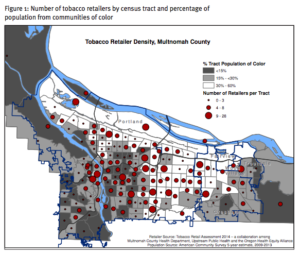
Multnomah County, Oregon: the Multnomah County Health Department and the Oregon Health Equity Alliance conducted assessments of 411 stores that sell tobacco. While Oregon does not require licensing to sell tobacco products, a list of 590 tobacco retailers was created from various sources. Assessments were conducted at 411 of the 590 locations. They documented the number of stores located within 1000ft of schools, offering price discounts, displaying tobacco products within 12 inches of candy, and more. Read the full report here, as well as special reports for the City of Portland, and the Cities of Fairview, Gresham, Troutdale and Wood Village. Data from these assessments were also used to assess the health equity impact of a potential tobacco retailer licensing policy in Multnomah County communities.
Milwaukee, Wisconsin
In Milwaukee, WI, the STARS tool was used to identify and document disparities in the tobacco retail environment. Three demographically distinct zip code clusters (3 predominantly African-American zipcodes, 2 predominantly Latino/Hispanic zipcodes, and 4 predominantly white zip codes) were selected, and community tobacco control workers and volunteers conducted store assessments at a random sample of retailers from each. Menthol cigarettes were more often advertised outside retailers and available at a discount in the African-American cluster. The average cheapest pack of cigarettes was $5.80 in the Hispanic cluster, $6.13 in the African-American cluster, and $6.40 in the white cluster. While e-cigarettes were more often available at stores in the white cluster, they were more often placed near candy or sold at a discount in the African-American cluster. Similarly, cigarettes were more likely to be displayed near candy, advertised within 3 ft of the floor, and sold at a discount in the African-American cluster. Little cigars/cigarillos were also more likely to be displayed near candy in the African-American cluster, and were least often sold as singles or for less than $1 in the white cluster. The stakeholders involved in the project used these findings to discuss appropriate policy interventions, such as a state-level minimum floor price for cigarettes, prohibiting price discounts, and zoning restrictions to reduce point-of-sale disparities seen across the city. Following the success of this project, the Wisconsin Tobacco Prevention and Control Program adopted STARS to conduct store assessments across the state. Counter Tools provided technical assistance on the STARS tool for this project.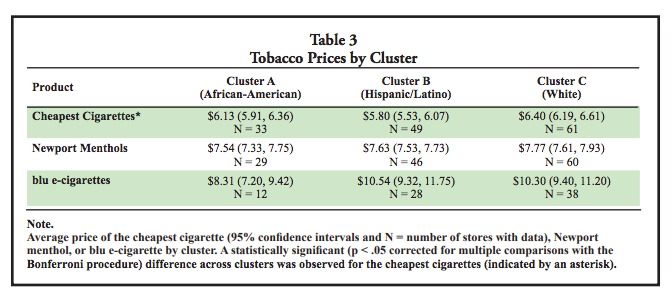
This project involved multiple stakeholders including: The Wisconsin Tobacco Prevention Control Program, the University of Wisconsin-Milwaukee, City of Milwaukee Tobacco Free Alliance; Tobacco-Free Suburban Milwaukee & Ozaukee Counties; The Wisconsin Tobacco Prevention and Poverty Network; The Wisconsin African American Tobacco Prevention Network; and the The Wisconsin Hispanic/Latino Tobacco Prevention Network. Read the full paper, published in Tobacco Regulatory Science: Identifying Disparities and Policy Needs with the STARS Surveillance Tool.
Building Community Awareness
Maryland
Maryland: The Cigar Trap, an education and awareness campaign around the issues associated with the merchandising and promotion of cigars. In Maryland in 2010 14.1% of high school students under 18 reported smoking cigarettes in the last 30 days. 13.9% reported smoking cigars. This represents more than an 11% increase in cigar use since 2000. The Cigar Trap highlights this shift in usage and the associated dangers. The campaign includes facts sheets to define the issue, solutions that can be pursued, and media resources associated with the campaign. Media resources can also be accessed through the CDC’s Media Campaign Resource Center.
Minnesota
The American Lung Association in Minnesota’s “Lethal Lure” Campaign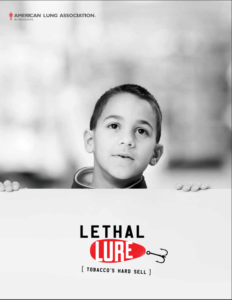 developed a tool kit to educate the general public and elected officials about the many tactics the tobacco industry uses to target youth and adults at the point of sale. A recent study showed lower support for point of sale tobacco control policies than for other areas of tobacco control. Building community awareness for POS policies that may be unfamiliar to the general U.S. population and building support for POS policies at the local level are ways to increase overall public support for national policy change. The tool kit includes 1 page issue briefs on a number of point of sale tobacco control topics. Each includes 1) an overview of the issue, 2) public health concerns nd 3) potential regulatory options at the local level.You can download the complete Lethal Lure Tool Kit in full or each issue 1-pager individually. In addition to a Glossary of Terms, these include:
developed a tool kit to educate the general public and elected officials about the many tactics the tobacco industry uses to target youth and adults at the point of sale. A recent study showed lower support for point of sale tobacco control policies than for other areas of tobacco control. Building community awareness for POS policies that may be unfamiliar to the general U.S. population and building support for POS policies at the local level are ways to increase overall public support for national policy change. The tool kit includes 1 page issue briefs on a number of point of sale tobacco control topics. Each includes 1) an overview of the issue, 2) public health concerns nd 3) potential regulatory options at the local level.You can download the complete Lethal Lure Tool Kit in full or each issue 1-pager individually. In addition to a Glossary of Terms, these include:
Youth Engagement
Audobon, Iowa
 Iowa Students for Tobacco Education and Prevention (ISTEP) is a youth-led tobacco prevention movement with a network of local chapters across the state. A chapter in Audubon, IA, a small, rural community in the Southwestern part of the state, recently used CounterTobacco.org’s Walking Tobacco Audit to uncover the problem of tobacco use and tobacco advertising in their community. During the activity, the students noticed some large outdoor advertising of low priced tobacco products at the Dollar General store, and decided they would all write letters to the Dollar General Corporation and ask them to take the sign down, citing examples of how tobacco advertising is aimed at youth and other populations. The Dollar General Corporation responded by sending a letter back to the group, and took down the sign in Audubon! These large yellow outdoor advertisements were also taken down from Dollar General stores across the state. Read more here.
Iowa Students for Tobacco Education and Prevention (ISTEP) is a youth-led tobacco prevention movement with a network of local chapters across the state. A chapter in Audubon, IA, a small, rural community in the Southwestern part of the state, recently used CounterTobacco.org’s Walking Tobacco Audit to uncover the problem of tobacco use and tobacco advertising in their community. During the activity, the students noticed some large outdoor advertising of low priced tobacco products at the Dollar General store, and decided they would all write letters to the Dollar General Corporation and ask them to take the sign down, citing examples of how tobacco advertising is aimed at youth and other populations. The Dollar General Corporation responded by sending a letter back to the group, and took down the sign in Audubon! These large yellow outdoor advertisements were also taken down from Dollar General stores across the state. Read more here.
Ulster, Dutchess, and Sullivan Counties, New York
The Tobacco Marketing Education and Awareness Video Project, a joint project between Tobacco Free Action Communities (TFAC) of Ulster, Dutchess, and Sullivan Counties in New York State and the Ellenville High School Media Arts program, was inspired by the January 1, 2016 enactment of Ulster County, NY’s new law requiring a local license to sell tobacco and prohibiting new tobacco retailers from operating within 1000 feet of schools. Tobacco Free Action Communities (TFAC) of Ulster, Dutchess, and Sullivan Counties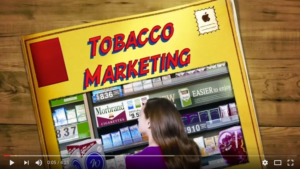 collaborated with the Media Arts production class at the high school, to create the educational videos on how tobacco marketing influences youth smoking. The videos were intended to educate the community on how in-store tobacco marketing is a leading cause of youth smoking. They were aired on the local public access TV station to educate Ulster County residents about tobacco point of sale marketing and will also be used in TFAC’s educational programs. New York State Department of Health, Bureau of Tobacco Control funds TFAC to increase support for New York State’s tobacco-free norm through youth action and community engagement. Ellenville High School Media Arts students were recognized by the Ulster County Legislature on March 15, 2016 with the “Pride of Ulster” Award for their contributions.
collaborated with the Media Arts production class at the high school, to create the educational videos on how tobacco marketing influences youth smoking. The videos were intended to educate the community on how in-store tobacco marketing is a leading cause of youth smoking. They were aired on the local public access TV station to educate Ulster County residents about tobacco point of sale marketing and will also be used in TFAC’s educational programs. New York State Department of Health, Bureau of Tobacco Control funds TFAC to increase support for New York State’s tobacco-free norm through youth action and community engagement. Ellenville High School Media Arts students were recognized by the Ulster County Legislature on March 15, 2016 with the “Pride of Ulster” Award for their contributions.
Demonstrations at Altria Annual Shareholders’ Meeting
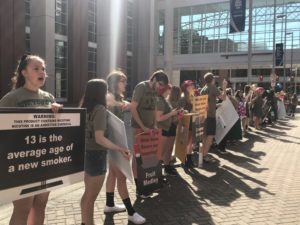 Youth activists from various groups have been demonstrating at Big Tobacco company shareholder meetings, including at Philip Morris (now called Altria), Philip Morris International, Philip Morris USA, and Reynolds American for nearly two decades to hold these companies accountable for their actions and demand change. In the latest iteration of these demonstrations, the youth group Reality Check of New York has worked with other youth groups such as No Limits from Nebraska, Dover Youth to Youth from New Hampshire, and Kick Butts Generation from Delaware each year since 2015 to plan and lead a rally outside of the annual Altria shareholders meeting in Richmond, VA. Learn more about the rallies here.
Youth activists from various groups have been demonstrating at Big Tobacco company shareholder meetings, including at Philip Morris (now called Altria), Philip Morris International, Philip Morris USA, and Reynolds American for nearly two decades to hold these companies accountable for their actions and demand change. In the latest iteration of these demonstrations, the youth group Reality Check of New York has worked with other youth groups such as No Limits from Nebraska, Dover Youth to Youth from New Hampshire, and Kick Butts Generation from Delaware each year since 2015 to plan and lead a rally outside of the annual Altria shareholders meeting in Richmond, VA. Learn more about the rallies here.
Engaging Stakeholders
Mountain Brook, Alabama
Point-of-sale tobacco control work is a newer strategy for many communities across the United Sates. Many have focused on other strategies such as raising the cigarette excise tax, implementing smokefree air laws, providing access to cessation services, and hard-hitting media campaigns. However, none of these strategies alone is a silver bullet. They all work together as pieces of the tobacco control puzzle, and work on one strategy can complement or energize work on another strategy. For example, whether or not your community is legally able or has the readiness to pass point-of-sale tobacco control policy, assessing the retail environment can help bring awareness to the presence of and norms around tobacco in your community and may lead to progress on other types of tobacco policy.No matter what type of policy you are pursuing, engaging stakeholders is a key part of the public health policy change process. Mountain Brook, Alabama provides an excellent example of successfully engaging with key community members and community stakeholders in order to pass a more comprehensive smokefree policy in the town. Read the full story here.
Kansas City Metro Area
As of February 2017, 22 localities in the Greater Kansas City Area had passed ordinances raising the minimum age for tobacco to 21. We talked with Scott Hall, Senior Vice President of Civic and Community Initiatives at the Greater Kansas City Chamber of Commerce to learn more about their “Tobacco 21” movement, including who was involved, how they made the case, the process for crafting the ordinances, how Tobacco 21 fits in to broader work preventing youth access to tobacco, lessons learned, and what’s next. Read the full story here.
San Francisco, California: Prohibiting the Sale of All Flavored Products, Including Menthol Cigarettes
In June 2017, San Francisco became the first city to completely restrict the sale of any flavored tobacco product, including menthol, within the city limits, without exception. Learn about the groundwork involved in making it happen and the ongoing work to keep the policy on the books.
Reversing Point-of-Sale Preemption
Colorado
Preemption is one of the biggest challenges in tobacco control and can impede policy change. However, reversing preemption is possible! During this webinar, part of Counter Tools’ Healthy POS Webinar Series, we discuss Colorado’s experience with preemption and efforts made to advance policy within the state. Colorado state law previously stated that “…In order to qualify for distribution of state income tax moneys, units of local government are prohibited from imposing fees, licenses, or taxes on any person as a condition for engaging in the business of selling cigarettes or from attempting in any manner to impose a tax on cigarettes.” This preventing localities from licensing cigarettes retailers or imposing their own cigarette taxes. However, this law was reversed in 2019. This webinar explores local-level case studies and the statewide work that led to reversing preemption. Speakers include:
- Mandy Ivanov, Health Promotion Coordinator with Eagle County Public Health and Environment
- Jodi Radke, Regional Director at the Campaign for Tobacco Free Kids
- Jill Bednare, Tobacco Policy Initiatives Supervisor at the Colorado Department of Health and Environment
- Moderator: Jackie Boards, Project Director at Counter Tools
Download the slides here and view the recording here or below:


